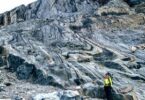Credit: NASA/JPL-Caltech
While we go about our daily activities on Earth, a nuclear-powered robot the size of a small car is orbiting Mars in search of fossils. Unlike its predecessor Curiosity, NASA’s Perseverance rover is clearly intended to “search for possible evidence of past life”, according to the official mission.
Jezero Crater was chosen as the main destination because it contains traces of ancient mud and other materials that were deposited where the river fed into the lake more than 3 billion years ago. We don’t know if there was life in that lake, but if there was, Mamello might find evidence of it.
We can imagine Mamello encountering large, well-preserved remains of microbial colonies—perhaps similar to the cabbage-like stromatolites that sun-dwelling bacteria produced along Earth’s ancient shores. Fossils like these would be large enough to be seen clearly by the rover’s cameras, and they might also contain chemical evidence. for ancient life, which the rover’s spectroscopic instruments could detect.
But even in such optimistic scenarios, we could not be sure that we had found fossils until we could see them under a microscope in laboratories on Earth. That is because it is possible for geological features produced by non-biological processes to resemble fossils. These are called pseudofossils. That’s why Perseverance doesn’t just look for fossils: it collects samples. If all goes well, about 30 samples will be returned to Earth in a follow-up project, planned in collaboration with the European Space Agency (ESA).
Earlier this month, NASA announced that a very interesting sample, the 24th Endurance and informally named “Comet Geyser”, has joined the rover’s growing collection. This is from an outcrop called Bunsen Peak, a rock deposit called the Margin Unit near the rim of the crater.
This group of rocks may have been formed near the shore of an ancient lake. The rover’s instruments showed that the Bunsen Peak sample is dominated by carbonate minerals (the main component of rocks such as limestone, chalk and travertine on Earth).
Small grains of carbonate are mixed together with pure silica (similar to opal or quartz). The NASA announcement quotes Ken Farley, Perseverance project scientist, as saying: “This is the type of rock we were hoping to find when we decided to explore Jezero Crater.”
But what is special about carbonates? And what makes the Bunsen Peak sample particularly exciting from the perspective of astronomy, the study of life in the universe? In fact, first, this rock may have formed under conditions that we can recognize as habitable: able to support the metabolism of life as we know it.
Patience entered Bunsen Peak, revealing the white color inside the rock. Credit: NASA/JPL-Caltech/ASU/MSSS
Another habitability factor is the availability of water. Carbonate and silica minerals can both form through direct precipitation from aquifers. Sample 24 may have descended from lake water under temperature and chemical conditions compatible with life, although other possibilities need to be tested. In fact, carbonate minerals are surprisingly rare on Mars, which has always had plenty of CO₂ available.
In the humid regions of early Mars, that CO₂ would have dissolved in water and reacted to form carbonate minerals. The analysis of Bunsen Peak and Sample 24 when sent to Earth, may finally help us solve this mystery. One face of the outcrop has interesting and streaky textures that may clarify its origin, but are difficult to interpret without further details.
Second, we know from examples on Earth that ancient sedimentary carbonates can produce fossils. Such fossils include stromatolites made of carbonate crystals that have been directly digested by bacteria. Patience has not seen convincing examples of these.
There are large circular patterns on the Margin Unit but this is most likely the result of weathering. However, even where stromatolites are not present, however, some ancient carbonates on Earth contain remnants of microbial cells, which form ghostly images where structures before the cells are replaced by minerals.
The small grain size of the Comet Geyser sample indicates a high potential for fossil preservation. Under certain conditions, well-formed carbonates can retain organic matter – the modified remains of fats, pigments and other organic compounds. Silica cement makes such preservation easier: silica is generally harder, harder, and more impermeable than carbonate, and it can protect fossil organisms and molecules. living in rocks from chemical and physical changes over billions of years.
When my colleagues and I wrote a scientific paper called A Field Guide to Finding Fossils on Mars in preparation for this work, we specifically recommended that silicified rock samples be made. for these reasons. Of course, to open this sample and explore its secrets, we need to return it to Earth.
An independent review recently criticized NASA’s plans to return samples from Mars as too risky, too slow and too expensive. Modified mission buildings are now being explored to meet these challenges. Meanwhile, hundreds of talented scientists and engineers at NASA’s Jet Propulsion Laboratory in California lost their jobs because the US Congress effectively cut funding for the Mars sample return by failing to provide support required.
The return of the Mars model remains NASA’s highest priority in planetary science and is strongly supported by the global planetary science community. Examples of Perseverance can change the way we view life in the universe. Even if they contain no fossils or biomolecules, they will fuel decades of research and give future generations a completely new perspective on Mars. Let’s hope that NASA and the US government can live up to the name of their rover, and they promise.






